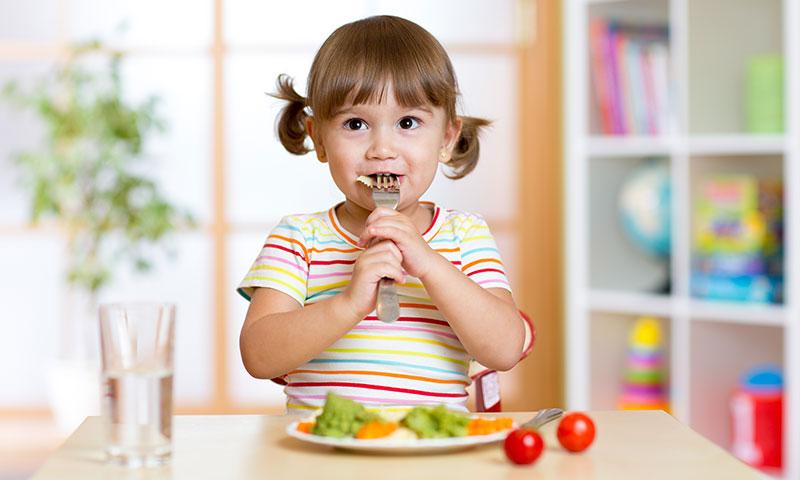Healthy eating is essential for your child’s good health, growth and development. Healthy eating in childhood means they will have less chance of developing chronic diseases like heart disease, type 2 diabetes, obesity and some cancers. It will also mean they feel better, look better and enjoy life more.
The Australian Dietary Guidelines recommend children should enjoy a wide variety of foods from these five food groups:
- fruit
- vegetables, legumes and beans
- cereals (including breads, rice, pasta and noodles), preferably wholegrain
- lean meat, fish, poultry and/or alternatives
- milks, yoghurts, cheeses and/or alternatives (children under 2 should have full fat milk, but older children and adolescents should be encouraged to have reduced-fat varieties).
How much food does my child need?
- 2 – 3 years: 1 serve of fruit; 2½ serves of vegetables; 4 serves of grains; 1 serve of meat/poultry; 1½ serves of dairy
- 4 – 8 years: 1½ serves of fruit; 4½ serves of vegetables; 4 serves of grains; 1 ½ serves of meat/poultry; 1½ – 2 serves of dairy
- 9 – 11 years: 2 serves of fruit; 5 serves of vegetables; 4 – 5 serves of grains; 2½ serves of meat/poultry; 2½ – 3 serves of dairy
- 12 – 13 years: 2 serves of fruit; 5 – 5 ½ serves of vegetables; 5 – 6 serves of grains; 2 ½ serves meat/poultry; 3 ½ serves dairy.
Tips to encourage healthy eating habits
- make mealtime family time, without any screens
- make healthy foods fun, for example by cutting fruit or sandwiches into interesting shapes
- encourage your children to sit with you at the table
- eat a healthy breakfast every day
- try out new foods and show your children where food comes from; let them help you buy food from the shops
- cook and try new recipes together
- don’t keep junk food in the house
- keep a bowl of fruit handy for a snack
- wash your hands and make sure food is prepared and stored safely.
Foods to limit
Some foods are not essential in children’s diets. These are called ‘discretionary foods’ and are generally high in kilojoules, saturated fat, added sugars or added salt.
It’s OK to eat small amounts of discretionary foods now and then as part of a balanced diet. But you should try to limit these foods in your child’s daily diet since they can lead to children becoming overweight or developing diseases in later life.
Examples of foods to limit are:
- sweet biscuits, cakes and desserts
- processed meats and sausages
- ice-cream, confectionery and chocolate
- meat pies and other pastries
- commercial burgers, pizza, hot chips, and fried foods
- crisps and other fatty and/or salty snacks
- cream and butter
- sugar-sweetened cordials and soft drinks.
Here are some tips to help you limit foods for children:
- Instead of using a lot of butter, cooking margarine, cream or coconut or palm oil, choose vegetable oils, spreads, nut butters/pastes and avocado.
- Read labels and always choose low-salt options.
- Don’t add salt to foods during cooking or at the table.
- Offer water rather than sugary soft drinks, cordial, energy drinks or sports drinks.

